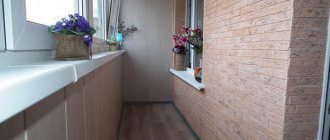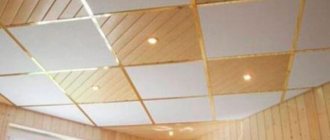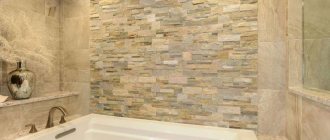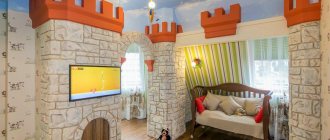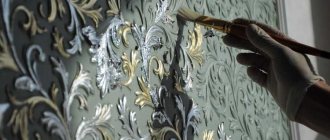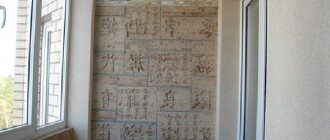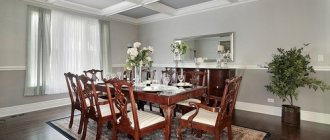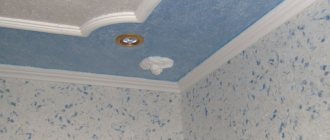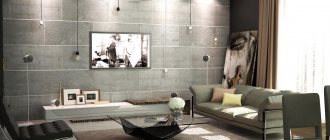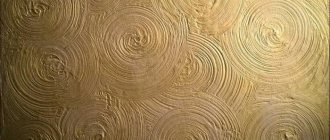Peculiarities
Paints of this type are used for painting verandas, terraces, workshops, garages and other objects. They have good adhesion, moisture resistance and heat resistance. This group of coatings is not afraid of sudden temperature changes, which are detrimental to most standard decorative and protective coatings.
Other benefits include:
- quick drying;
- no pungent odor;
- good hiding power;
- compatibility with various types of surfaces.
Ordinary interior paints are not suitable for this purpose: at temperatures below +5 degrees, such a coating cracks and becomes stained. Instead, you can use liquid wallpaper that is resistant to temperature changes and high humidity. Another common solution is to cover the walls with PVC panels, moisture-resistant plasterboard or clapboard.
Lifehack! Facade paints can be used to decorate walls in unheated rooms. They have an increased level of moisture resistance and are not afraid of temperature changes.
When can you plaster wooden walls?
Is the wooden house completed, repair or reconstruction work completed? There is a great desire to carry out finishing work as quickly as possible and celebrate housewarming. But we'll have to wait.
Wood has a tendency to shrink. Typically, the process is completed within a year or two. The exception is frame houses. Special blocks made of wood and insulation in them are not load-bearing structures. They are not subject to deformation over time. You can immediately begin roughing and then finishing.
For all other wooden buildings, a number of conditions must be met:
- air humidity - not higher than 70%, wood - 12%;
- air temperature - from 10°C to 30°C.
At higher rates, the mixture dries out very quickly and cracks. And low temperatures prevent setting. Therefore, it is not recommended to carry out work in winter. Artificial heating can improve the situation, but not much. Drying the house itself and the layers of plaster should take place in the most natural conditions possible.
READ What is the difference between a stone and a brick psychiatrist
Important point! The possibilities for plastering the inside of a house are not limited only to external conditions, temperature and humidity requirements. The height difference on the walls matters. If it exceeds 4-5 cm, it is better to use sheets of drywall for leveling. The thicker the layer of plaster, the higher the likelihood that it will crack and move away from the original wooden surface.
Plastering manually and mechanically
Previously, we talked about the manual option of applying plaster composition to wooden walls. The process is labor-intensive and time-consuming. If the house has a large area, then even rough finishing takes months.
You can significantly speed up the process if you use a special machine for spraying the composition. Advantages of mechanized plastering compared to the manual method:
- the solution is prepared automatically (just select the desired program);
- the mixture is applied to the wall more densely and evenly;
- the work time for grouting walls and the time for complete drying are reduced;
- adhesion improves with both horizontal and vertical surfaces.
Fastening shingles
Wooden surfaces have poor contact with the mortar and require additional reinforcement. A tried and true method for strengthening and leveling wood using plaster is to hammer a wooden mesh into the cross. Thin slats are used, no more than 5 mm thick, otherwise a layer of plaster will grow, and at the same time the consumption of materials. The first layer is stuffed from the corner with smaller nails, diagonally, keeping the distance between the shingles 4-5 cm. The lath is attached only at the edges. On top of the first layer, the shingles material is stuffed perpendicularly with large nails into the crosshairs. The optimal cell size is 40x40 mm.
Attention! Before work, the shingles are soaked in water for a couple of hours so that the nails do not split it.
Covering
A thin finishing layer is applied to eliminate any remaining defects after the base primer.
Grout
After the rough soil has set, use a trowel to smooth the surface of the plaster with careful rotational movements. The surface is leveled as much as possible. If you rub counterclockwise, the solution thickens.
Cement-based composition
The binding agent of the solution is cement, which is produced from a mixture of limestone and clay, fired using a special technology. Filler – sand. The thickness of the applied layer depends on the size of its fractions, which simplifies the work on shingles. The grade of cement affects the strength. Water is used for kneading. The base, made of sand and cement, can withstand exposure to water, high and low temperatures, and increased loads.
Ready-made dry mixtures contain additional additives, for example, the insulated mixture includes perlite, the antibacterial mixture contains slaked lime. Added synthetic substances:
- increase the plasticity of the solution;
- reduce the specific gravity of the screed;
- increase adhesion to the base;
- protect from exposure to acid-base environments and x-rays.
Additional ingredients make it possible to plaster at sub-zero temperatures. Adding reinforcing materials allows you to increase the thickness of the layer. The only disadvantage of the ready-made mixture is the high price.
How to plaster wooden walls
In order not to have to constantly repair the house or watch pieces of shingles fall off, it is important to choose the right composition for leveling wooden walls. There are mixtures:
- for outdoor work;
- for internal;
- universal.
- standard, leveling;
- thermal insulation;
- soundproofing;
- moisture resistant;
- decorative (they are not suitable for leveling walls, but they allow you to create real masterpieces on the walls).
Read more about other types of plaster in this article.
Now it remains to talk about the composition of the plaster mixtures. As a basis for them, gypsum, lime, cement, and clay are used.
Varieties
For fine finishing in rooms that are not heated, water-based or solvent-soluble paints are suitable. The choice of coatings on the market is huge: finding a coating with the desired texture and color is not difficult. But resistance to low temperatures and high humidity is characteristic only of a limited number of paints.
Water-based
The safest available and widespread paintwork materials. They do not contain toxic components, are odorless, and form a durable decorative and protective coating in just a few hours. Can be used for painting rooms where there will be small children, allergy sufferers, and pets.
An important advantage of water-based materials is ease of tinting. It is easy to give them the desired shade, from delicate pastels to bright varnish: to do this, just purchase a special tinting paste, sold in any hardware store. Upon completion of painting work, wash the tools with plain water.
Acrylic
Acrylic coatings are at the peak of popularity. They are suitable for painting heating system elements and doors, walls and ceilings, furniture and individual interior items. Acrylic-based coatings demonstrate good adhesion to various types of surfaces:
- tree;
- concrete;
- metal;
- plasterboard.
To improve the adhesive properties of the material, the substrate is pre-primed.
The paint forms a decorative protective film that protects the base from moisture, temperature fluctuations, and mold development. Thanks to its dense structure, it masks some defects in the substrate - nail marks, minor cracks. The hardened coating can be washed with water and standard detergents.
Acrylic paint dries quickly, has no unpleasant odor, and is easily tinted to the desired shade. To achieve the desired color, before starting work, mix the composition thoroughly, adding color according to the instructions on the package. To check the consistency of the resulting shade, it is tested on a piece of cardboard or paper, waiting for complete curing. If the color turns out to be too dark, add white paint, if the color is light.
Silicone
Silicone paints are valued for their good hiding power. The material is consumed economically, forming a durable and elastic coating. It is resistant to ultraviolet rays and does not fade in the sun.
Silicone paints and varnishes have other advantages:
- Vapor permeability. After drying, they form a specific porous coating that blocks the passage of moisture, but allows water vapor to pass through. This property is especially important in the cold season: the walls dry out faster, which is why dampness does not linger in the room, and the finish retains its attractive appearance longer. A high degree of vapor permeability allows the use of silicone paints and varnishes for painting mineral wool insulation.
- Easy to clean. Dust accumulated on the walls during operation is easily washed off with water: it flows freely over the surface without being absorbed into its structure. Due to this, silicone-based paints are often used in public buildings and institutions with high traffic.
Silicone coatings are durable: they last at least 10-15 years. This type of paint and varnish materials can be used for interior decoration of unheated rooms and for painting building facades.
